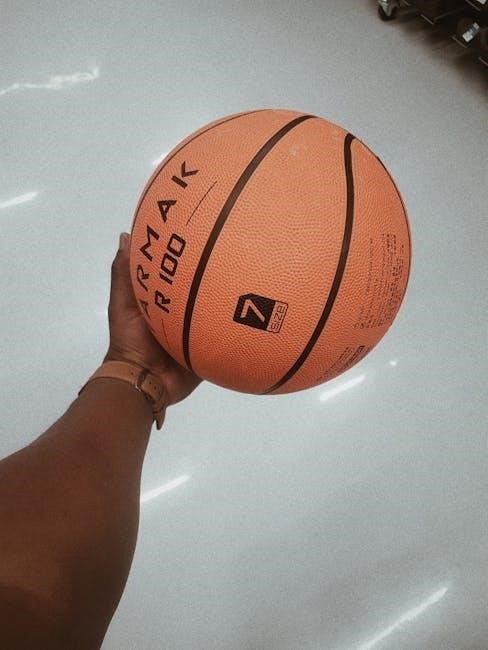Basketball weight training programs enhance strength, power, and endurance, crucial for on-court performance. They are periodized into off-season, pre-season, and in-season phases, focusing on muscle growth, explosiveness, and maintenance. These structured plans incorporate compound movements and functional exercises to improve jumping ability, speed, and injury resistance, ensuring players are physically prepared for the demands of the game at every stage.
1.1 Importance of Strength and Conditioning in Basketball
Strength and conditioning are foundational for basketball success, enhancing power, speed, and endurance. They improve explosiveness for jumps and sprints, reduce injury risk, and build resilience for sustained performance. A well-structured program ensures players can meet the physical demands of the game, from rebounds to fast breaks, while maintaining peak form throughout the season.
1.2 Overview of a Basketball Weight Training Program
A basketball weight training program is structured to enhance performance through targeted phases. It includes off-season mass and strength cycles, pre-season hypertrophy, and in-season maintenance. The program incorporates compound movements, functional exercises, and periodization to build power, endurance, and agility. This comprehensive approach ensures players are physically prepared to meet the demands of the game while minimizing injury risks and optimizing overall athletic development.
Off-Season Basketball Weight Training Program
The off-season program lasts 20 weeks, divided into three cycles: mass and strength (weeks 1-7), power and explosiveness (weeks 8-14), and endurance and agility (weeks 15-20). This periodized approach builds a strong foundation, enhancing performance while minimizing injury risks through progressive overload and focused training.
2.1 Mass and Strength Cycle (Weeks 1-7)
This phase focuses on building overall muscle mass and foundational strength through compound exercises like bench presses, squats, deadlifts, and lunges. Players start with moderate weights and higher reps (3×10) to promote hypertrophy, then gradually increase intensity, lowering reps (4×6) with heavier loads to maximize strength gains by week 7, ensuring a solid base for future power development.
2.2 Power and Explosiveness Phase (Weeks 8-14)
This phase transitions from strength to power, focusing on explosive movements like hang snatches, broad jumps, and box jumps. Players perform lower reps (3-5) with higher intensity to enhance neuromuscular coordination and force production. Exercises are designed to mimic basketball actions, such as jumping and sprinting, to improve vertical leap and acceleration, preparing athletes for the demands of the game.
2.3 Endurance and Agility Development (Weeks 15-20)
During weeks 15-20, the focus shifts to building endurance and agility, essential for maintaining performance over the game’s duration. Players engage in high-intensity interval training, lateral drills, and plyometric exercises. These workouts improve cardiovascular stamina, quick changes of direction, and reaction speed, ensuring athletes can sustain peak performance throughout the season and adapt to the fast-paced nature of basketball.
Pre-Season Basketball Weight Training Program
The pre-season program focuses on hypertrophy and muscle balance to enhance explosiveness and speed. It includes plyometric exercises, agility drills, and strength training to prepare players for competition.
3.1 Hypertrophy and Muscle Balance Focus
The pre-season phase emphasizes hypertrophy to build muscle mass and balance, addressing strength deficits. It includes exercises like bench presses and squats to target major muscle groups, improving overall power and stability. This phase ensures players develop proportional strength, reducing injury risks while enhancing athletic performance on the court.
3.2 Explosiveness and Speed Training
Explosiveness and speed training are prioritized in the pre-season to enhance players’ ability to accelerate and decelerate quickly. Techniques include plyometrics, sprint drills, and resisted runs. These methods improve fast-twitch muscle fibers, essential for basketball’s dynamic movements. The goal is to maximize power and agility, enabling players to dominate in sprints, jumps, and rapid directional changes during games.

In-Season Basketball Weight Training Program
In-season basketball weight training focuses on maintaining strength, power, and endurance while minimizing injury risk and enhancing recovery. Workouts are tailored to the game schedule demands.
4.1 Maintenance of Strength and Power
In-season weight training emphasizes maintaining strength and power with reduced volume. Focus on compound exercises like squats, deadlifts, and bench presses to sustain muscle mass and explosiveness. Lower-intensity sessions ensure recovery while preserving athletic capabilities. This phase prioritizes injury prevention and maintaining peak performance levels throughout the season without overtraining.
4.2 Injury Prevention and Recovery Strategies
Injury prevention focuses on strengthening vulnerable areas like knees, ankles, and shoulders. Recovery strategies include foam rolling, stretching, and ice baths to reduce muscle soreness. Proper hydration, nutrition, and sleep are emphasized to enhance repair. These practices ensure players maintain optimal physical condition and minimize downtime during the competitive season, supporting long-term durability and performance.
Strength and Conditioning Exercises for Basketball
Basketball strength and conditioning exercises focus on building lower body strength, upper body power, and core stability. They improve explosiveness, speed, and overall performance on the court.
5.1 Lower Body Strength Exercises (Squats, Deadlifts, Lunges)
Squats, deadlifts, and lunges are essential for building lower body strength, enhancing explosiveness, and improving jumping ability. Squats target the quadriceps and glutes, deadlifts strengthen the hamstrings and core, while lunges ensure balance and stability. These exercises are fundamental for basketball players, as they directly translate to powerful jumps, faster sprints, and better overall performance on the court.
5.2 Upper Body Strength Exercises (Bench Press, Pull-Ups, Dumbbell Flies)
The bench press strengthens the chest and triceps, enhancing pushing power. Pull-ups develop the back and arms, improving overall upper body endurance. Dumbbell flies target the shoulders, boosting stability and mobility. These exercises are crucial for basketball, as they enhance rebounding, defending, and overall upper body performance, while also contributing to injury prevention and long-term durability on the court.
5.3 Core and Functional Training Exercises
Core exercises, such as planks and Russian twists, improve stability and rotational strength, essential for basketball movements. Functional training includes medicine ball throws and cable rotations, mimicking game actions like passing and cutting. These exercises enhance balance, agility, and overall athleticism, allowing players to maintain control during quick changes of direction and explosive jumps, while also reducing injury risk.
5.4 Compound Movements for Power Development
Compound movements like hang cleans, snatches, and push presses are essential for basketball players to develop explosive power. These exercises improve neuromuscular coordination and generate force quickly, translating to powerful jumps and rapid accelerations. Proper form and progressive overload ensure safety and maximize gains, making these movements critical for enhancing court performance and overall athleticism in a structured training program.
Periodization of the Weight Training Program
Periodization structures training into macro-cycles (annual plans) and micro-cycles (weekly/daily workouts), ensuring progressive overload and recovery. This approach prevents overtraining and enhances performance, aligning with basketball season demands.
6.1 Macro-Cycle: Annual Training Plan
The macro-cycle is an annual training plan divided into off-season, pre-season, and in-season phases. Each phase focuses on specific goals, such as building strength, enhancing power, or maintaining performance. This structured approach ensures players peak during critical competition periods while balancing recovery and progression throughout the year. Proper periodization prevents overtraining and optimizes physical development for basketball success.
6.2 Micro-Cycles: Weekly and Daily Workouts
Micro-cycles involve detailed weekly and daily workout plans tailored to specific training phases. They combine strength, power, and conditioning exercises, with rest periods to avoid overtraining. Each workout targets different muscle groups, ensuring balanced development. For example, lower body and upper body days alternate with agility drills, promoting recovery and consistent progress toward basketball-specific fitness goals throughout the season.
Injury Prevention and Recovery Strategies
Injury prevention and recovery strategies focus on strength, flexibility, and balance to reduce injury risks. Techniques include foam rolling, stretching, and ice baths to enhance recovery.
7.1 Common Injuries in Basketball and Their Prevention
Basketball commonly causes injuries like ankle sprains, knee ligament tears, and shoulder dislocations due to explosive movements and contact. Prevention focuses on strengthening muscles around joints, improving flexibility, and enhancing balance through targeted exercises. Incorporating injury-specific drills and proper warm-up routines can significantly reduce the risk of these injuries, ensuring long-term player health and performance.
7.2 Recovery Techniques (Foam Rolling, Stretching, Ice Baths)
Recovery techniques like foam rolling, stretching, and ice baths are essential for basketball players to reduce muscle soreness and improve flexibility. Foam rolling enhances blood flow and relieves tight muscles, while stretching improves range of motion and prevents stiffness. Ice baths reduce inflammation and muscle spasms, aiding in faster recovery after intense workouts and games.

Nutrition and Supplementation for Basketball Players
A balanced diet rich in protein, carbohydrates, and fats fuels performance and recovery. Proper hydration and electrolyte balance are crucial. Supplements like protein powder and creatine can enhance recovery and performance, supporting muscle growth and energy levels during intense training and competition.
8.1 Importance of Protein, Carbohydrates, and Fats
Protein, carbohydrates, and fats are essential for energy, recovery, and performance in basketball. Protein rebuilds and strengthens muscles, while carbohydrates provide fuel for high-intensity activities; Fats support hormone production and overall bodily functions. A balanced intake ensures optimal energy levels, aids in recovery, and supports muscle growth, making them critical components of a basketball player’s diet.
8.2 Hydration and Electrolyte Balance
Proper hydration and electrolyte balance are vital for basketball performance. Water aids energy production and physical function, while electrolytes like sodium and potassium regulate nerve and muscle activity. Dehydration and imbalances can lead to fatigue, cramps, and decreased performance. Players should drink water before, during, and after games, and consume electrolyte-rich foods or supplements to maintain optimal levels.
8.3 Supplements for Recovery and Performance
Supplements like protein shakes, creatine, and BCAAs support muscle recovery and performance in basketball. Protein aids muscle repair, while creatine enhances energy and endurance. BCAAs reduce muscle soreness and fatigue. These supplements, when combined with proper nutrition, help optimize recovery, allowing players to train harder and perform at their best during games and practices.

Age-Specific Basketball Weight Training Programs
Age-specific basketball weight training programs ensure tailored development for different age groups. Youth focus on foundational strength and injury prevention, while collegiate and professional athletes emphasize advanced power and endurance.
9.1 Youth Basketball Players (Under 12-18 Years)
For youth basketball players, weight training focuses on injury prevention and foundational strength. Programs emphasize proper technique, bodyweight exercises, and light resistance to build coordination and agility. These age-specific routines avoid heavy lifting, prioritizing long-term development and functional movement skills to prepare young athletes for future competition without risking overtraining or burnout.
9.2 Collegiate and Professional Basketball Players
Collegiate and professional basketball players require intense, customized weight training programs to enhance strength, power, and endurance. These advanced routines focus on explosive movements, sport-specific exercises like squats and deadlifts, and periodized cycles to peak performance during the season. Programs also emphasize injury prevention and recovery strategies to maintain elite-level conditioning and durability throughout the competitive year.

Position-Specific Weight Training Programs
Position-specific weight training programs tailor exercises to basketball roles, with guards focusing on speed and agility, while forwards and centers emphasize strength, power, and rebounding techniques.
10.1 Guards: Speed, Agility, and Endurance Focus
Guards require specialized training to enhance speed, agility, and endurance. Exercises like lateral box jumps, tuck jumps, and hang snatches improve explosiveness and quickness. Agility drills, such as ladder drills and cone exercises, refine footwork and directional changes. Endurance-focused workouts, including HIIT and pro agility shuttle runs, ensure guards maintain stamina throughout games, enabling them to outperform defenders and maintain offensive pressure effectively.
10.2 Forwards and Centers: Strength, Power, and Rebounding Focus
Forwards and centers require strength and power for rebounding and post play. Exercises like squats, deadlifts, and box jumps build lower body strength and explosiveness. Power-focused movements, such as hang cleans and medicine ball throws, enhance rebounding ability. Additionally, core stability exercises and pull-up variations improve overall durability and dominance in the paint, making them formidable defenders and rebounders.
Monitoring Progress and Adjusting the Training Program
Monitoring progress involves tracking strength, speed, and agility gains, allowing coaches to adjust the program based on performance and goals, ensuring continuous improvement and optimal results.
11.1 Tracking Strength, Speed, and Agility Gains
Regularly monitoring strength, speed, and agility improvements is essential for optimizing basketball training. Coaches use performance tests, such as bench press max, sprint times, and agility drills, to assess progress. Tracking workout data and athletic metrics ensures players are meeting goals and identifies areas needing adjustment, helping refine the training program for better results and peak performance.
11.2 Adjusting the Program Based on Performance and Goals
Adjusting the training program involves continuous assessment of player progress and alignment with seasonal goals. Coaches modify exercises, intensity, and volume based on performance data and feedback. This ensures the program remains effective, addressing strengths and weaknesses while preventing plateaus. Periodized training cycles, such as strength or power phases, are tailored to meet specific objectives, optimizing overall development and in-game performance.
